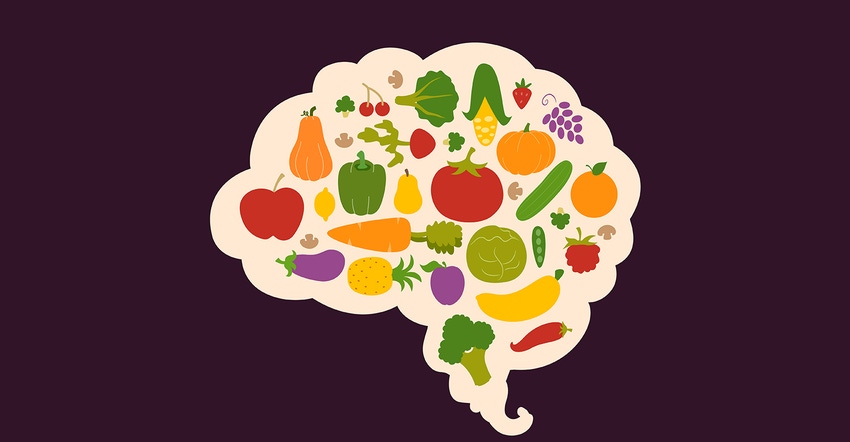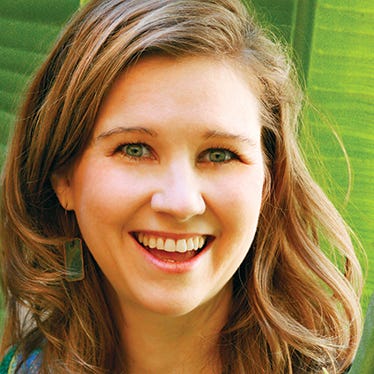Botanicals such as Ginkgo bilboa, bacopa, gotu kola, rosemary and sage may help support cognitive health.

People in many countries, including the U.S., are experiencing an increased life span.1 However, the aging population aims not just for increased, but optimized, years of life. Paramount to this are strategies to improve cognition or delay age-related cognitive decline. Supporting cognitive function is something that can, and should, be considered, even before the earliest signs of dementia are noticed.
Nootropic, a term coined in 1972 by Corneliu E. Giurgea, Ph.D, refers to a nontoxic substance that enhances learning and memory, facilitates communication between the brain hemispheres and enhances neurological resilience.2 Nootropics are commonly utilized to prevent or support early states of cognitive decline; they are also utilized by those who simply wish to optimize their cognitive function.
Cognitive function can be enhanced in a variety of ways. Studies show high levels of free radicals in the brains of those with cognitive decline.3 Antioxidants that can cross the blood-brain barrier tend to support cognitive function and protect the brain from the expected effects of aging. Vasodilators increase blood perfusion to the brain, enhancing oxygen levels and aiding glucose utilization.4 Substances that support neurotransmitter levels, particularly acetylcholine (ACh), can treat dementia.5 Finally, substances that support neurogenesis and increased neurological plasticity via modulation of brain-derived neurotrophic factor (BDNF) show great promise in enhancing cognitive function.6
Ginkgo bilboa (ginkgo) leaf is a well-known nootropic herb. Ginkgo trees belong to the Ginkgoaceae family, an ancient family cultivated for thousands of years for medicinal use in China. Much of the ginkgo used in research studies is a standardized product (EGb 761) of 22 to 27% flavonol glycosides, 5-7% terpene lactones, and less than 5 ppm ginkgolic acids. Ginkgo increases circulation to the brain, supporting glucose levels and adenosine triphosphate (ATP) utilization, and decreasing free-radical damage. Nootropic effects may also be due to increased levels of BDNF.6 Ginkgo is most effective when used for at least six weeks; long-term dosing is safe if the patient doesn’t have a clotting disorder or using anticoagulants (ginkgo thins the blood and should also be discontinued prior to surgery). Adulteration/contamination of ginkgo can be a concern,7 so analysis should be done on ginkgo sources to ensure a high-quality product.
Bacopa monnieri (water hyssop) is an Ayurvedic herb traditionally used as a medhya rasayana (memory/intellectual enhancer). Water hyssop grows in swampy or marshy areas; the arial portion of the plant is used, making it a very sustainable product. Sometimes referred to as brahmi, water hyssop is often contaminated with Centella asiatica.8 Water hyssop is a potent antioxidant that can cross the blood-brain barrier. Administration is protective against toxic exposure, including tobacco and common environmental contaminants with neurotoxic side effects.9,10 Water hyssop also increases cerebral blood flow and supports ACh levels.9 Additionally, early research seems to indicate enhancement of BDNF.6 Multiple studies have shown water hyssop improves memory acquisition and retention, as well as attention and memory processing. Results are most pronounced after three months of administration; short-term memory improvements are not seen in research studies, although many patients feel subjectively better even with short-term administration.
Centella asiatica (gotu kola, Indian pennywort) is used in Ayurvedic and traditional Chinese medicine (TCM). Along with water hyssop, it is sometimes called brahmi. Although the whole plant can be used, the arial portions are typically used for sustainability reasons. Gotu kola is an adaptogen, meaning it increases resilience in the body, and is particularly known for decreasing the effects of stress while enhancing memory.11 When used regularly, it facilitates a sense of tranquility,12 which supports memory and focus.13 Like water hyssop, it is a potent antioxidant and supports ACh levels,14 and the two herbs combine well in formulas.
A multitude of other nootropic herbs exist, but commonly used spices should also be considered for their nootropic effects. Rosemarinus officinalis (rosemary) leaf is treasured for nootropic effects in its native Mediterranean region. Rosemary is such a potent antioxidant that it is used as a preservative in food items, and that antioxidant action is thought to cross the blood-brain barrier. Rosemary enhances ACh levels,15 and supports a feeling of calm alertness that facilitates cognitive function. Salvia officinalis (garden sage) and Saliva lavandulifolia (Spanish sage) also possess potent antioxidant effects and modulate ACh, at least in part because of the shared volatile oil rosemarinic acid, considered neuroprotective.16 Spanish sage is considered the safer of the two sages due to absence of alpha- and beta-thujone.
People interested in preventing age-related cognitive decline could easily incorporate these herbs into their daily routine. It bears mentioning that regular exercise is the most-studied way to increase BDNF and neurogenesis,17 and improves vascularization to the brain.18 Activities that require novel mental thought, such as word puzzles and games, are also a proven way to optimize brain function.19
Learn more about healthy aging from Katie Stage during the “Healthy Aging: Antioxidants, Adaptogens & Cognition” session on Wednesday, Oct. 16 at 9 a.m., at SupplySide West in Las Vegas. This session is underwritten by Nutrition 21.
Katie Stage, ND, RH (AGH), is a naturopathic physician and registered herbalist who practices family medicine at the Southwest College of Naturopathic Medicine (SCNM) in Tempe, Arizona. Her areas of focus include optimizing women’s/men’s health, gastrointestinal (GI) disorders and mental health. In addition to her busy practice and role as associate professor, Stage serves as the director of SCNM’s Therapeutics Division. She is also faculty senate president.
References
1 Marsman D et al. “Healthy ageing: the natural consequences of good nutrition-a conference report.” Eur J Nutr. 2018;57(Suppl 2):15-34. DOI:10.1007/s00394-018-1723-0.
2 Arce E, Ehlers MD. “The Mind Bending Quest for Cognitive Enhancers”. Clin Pharmacol Ther. 2017;101(2):179-181. DOI:10.1002/cpt.524.
3 Huang WJ, Zhang X, Chen WW. “Role of oxidative stress in Alzheimer's disease.” Biomed Rep. 2016;4(5):519-522. DOI:10.3892/br.2016.630.
4 Suliman NA et al. “Establishing Natural Nootropics: Recent Molecular Enhancement Influenced by Natural Nootropic.” Evid Based Complement Alternat Med. 2016;2016:4391375. DOI:10.1155/2016/4391375.
5 Ferreira-Vieira TH et al. “Alzheimer's disease: Targeting the Cholinergic System.” Curr Neuropharmacol. 2016;14(1):101-115. DOI:10.2174/1570159X13666150716165726.
6 Sangiovanni E et al. “Botanicals as Modulators of Neuroplasticity: Focus on BDNF.” Neural Plast. 2017;2017:5965371. DOI:10.1155/2017/5965371.
7 Czigle S et al. “Ginkgo biloba Food Supplements on the European Market - Adulteration Patterns Revealed by Quality Control of Selected Samples.” Planta Med. 2018;84(6-07):475-482. DOI:10.1055/a-0581-5203.
8 Santhosh Kumar JU et al. “Assessment of adulteration in raw herbal trade of important medicinal plants of India using DNA barcoding.” 3 Biotech. 2018;8(3):135. DOI:10.1007/s13205-018-1169-3.
9 Aguiar S, Borowski T. “Neuropharmacological review of the nootropic herb Bacopa monnieri.” Rejuvenation Res. 2013;16(4):313-326. DOI:10.1089/rej.2013.1431.
10 Jyoti A, Sethi P, Sharma D. “Bacopa monniera prevents from aluminium neurotoxicity in the cerebral cortex of rat brain.” J Ethnopharmacol. 2007 Apr 20;111(1):56-62. Epub 2006 Nov 11.
11 Lokanathan Y et al. “Recent Updates in Neuroprotective and Neuroregenerative Potential of Centella asiatica.” Malays J Med Sci. 2016;23(1):4-14.
12 Gohil KJ, Patel JA, Gajjar AK. “Pharmacological Review on Centella asiatica: A Potential Herbal Cure-all.” Indian J Pharm Sci. 2010;72(5):546-556. DOI:10.4103/0250-474X.78519.
13 Robinson OJ et al. “The impact of anxiety upon cognition: perspectives from human threat of shock studies.” Front Hum Neurosci. 2013;7:203. DOI:10.3389/fnhum.2013.00203.
14 Kulkarni R, Girish KJ, Kumar A. “Nootropic herbs (Medhya Rasayana) in Ayurveda: An update.” Pharmacogn Rev. 2012;6(12):147-153. DOI: 10.4103/0973-7847.99949.
15 Habtemariam S. “The Therapeutic Potential of Rosemary (Rosmarinus officinalis) Diterpenes for Alzheimer's Disease.” Evid Based Complement Alternat Med. 2016;2016:2680409. DOI:10.1155/2016/2680409.
16 Lopresti AL. “Salvia (Sage): A Review of its Potential Cognitive-Enhancing and Protective Effects.” Drugs R D. 2017;17(1):53-64. DOI: 10.1007/s40268-016-0157-5.
17 Ferris LT, Williams JS, Shen CL. “The effect of acute exercise on serum brain-derived neurotrophic factor levels and cognitive function.” Med Sci Sports Exerc. 2007 Apr;39(4):728-34.
18 Cheng XW et al. “Exercise training stimulates ischemia-induced neovascularization via phosphatidylinositol 3-kinase/Akt-dependent hypoxia-induced factor-1 alpha reactivation in mice of advanced age.” Circulation. 2010;122(7):707-716. DOI:10.1161/CIRCULATIONAHA.109.909218.
19 Dartigues JF et al. “Playing board games, cognitive decline and dementia: a French population-based cohort study.” BMJ Open. 2013;3(8):e002998. Published 2013 Aug 29. DOI:10.1136/bmjopen-2013-002998.
About the Author(s)
You May Also Like






.png?width=800&auto=webp&quality=80&disable=upscale)